Volume XVI, Issue 4, November 2012
Page 7 < previous page > <next page>
On January 1st, 2005, Rally became a "titling" sport in AKC. M got her Novice title that first weekend: 2Qs on Saturday, 1 on Sunday, making her one of the first 2 basenjis to ever get an RN. The other was Digital. Mary Bloom took these photos of M for the AKC, & they are used with her permission.
In 2006, I put together this story about Rally, for the August Wrinkler, which was reprinted in the BCOA Bulletin.
BASENJIS SCORE 99 & 98 IN RALLY-O!
by Susan Kamen Marsicano, with contributions from Kim McNeill, Natalie Culver, and Nancy Banask
How about these basenjis! Although some of us are accustomed to hearing, “got to give it to you; training one of those dogs is like training a cat,” our basenjis are getting high scores and first placements in Rally-Obedience.
I truly believe that a set of Rally signs should be a part of every dog owner’s household. You can download the signs from the AKC site, or, better yet, purchase the signs, holders and numbers, plus Janice Dearth's AKC Rally Course book, from J & J Dog Supplies and go for it!
Beginnings
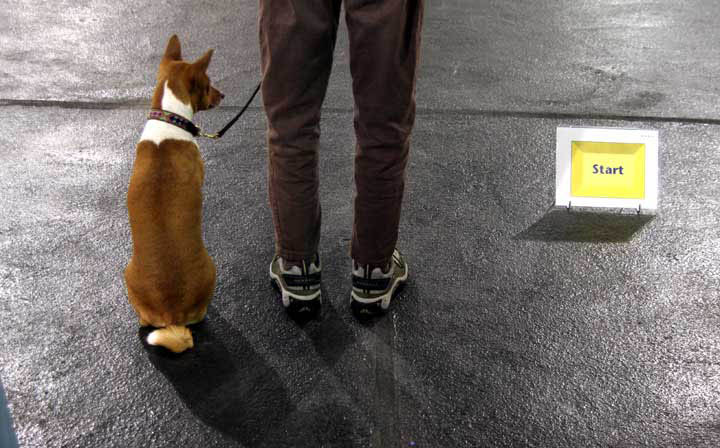
The originator of the sport of Rally Dog Obedience was Charles L. (Bud) Kramer.
Concerned with an apparent waning interest in traditional Obedience, resulting in large part, from the meteoric rise in the popularity of Agility, Bud conceived the basic concept of Rally Obedience and published the first article outlining the basis of the Rally concept in the February 2000 issue of Front and Finish. It was hoped that Rally would be attractive to those new to the sport of dogs and encourage an interest in obedience training by providing an alternative venue in the field of competitive obedience. Rally was established as an AKC titling event on January 1st, 2005.
Nancy Banask: “I have been involved with dog obedience since1965 and teaching obedience training classes for 25 years. Rally came about from the obedience exercises known as doodling. Doodling has been around for as long as I can remember. These exercises are an integral part of teaching heeling to your dog.”
HOW IT WORKSA Rally course is made of signs, which are, most often, on the handler’s right, so the handler can read the signs to the dog, who is in heel position, on the handler’s left. The sport encourages enthusiasm. The handler is judged from the knees down, so we need to learn the signs and get our feet in the right place. Other than that, body language is ours to use, plus as much prattle as we want. Rally teases us into relaxing and having fun, thus letting the dogs do the same.
And so, now, back to our basenjis and their high Rally-Obed. scores. Basenjis that I know of who have scored in the 90s are 1. Digital with a 95 and a 99 (both 1st Places), in Novice 2. M with a 95 in Novice, and a 96 and a 98 (1st Place) in Advanced, a 1st Place in Excellent. 3. Sandy with 2 scores of 94 in Novice, Occhi with a 92 in Novice.
![]()
![]()
![]()
by Kim McNeill:
I must admit, it was awfully fun to get the highest score in an obedience competition with a basenji.
After successfully performing my first AKC rally trials, Sue asked if I would help her out on an article about Rally. In a moment of weakness, heady after my 2 first places, I agreed. She suggested I do a blow by blow, or station by station play of Sunday’s rally course. The first day (my first rally trial ever) I competed with Jet, who earned a passing score of 86 out of 100 points, and Digital, who earned a score of 95 with a first place.
So I arrived on Sunday feeling confident that my dog could do this. (I only entered Digital on Sunday.) There was some waiting around as the upper levels usually go first and we had to wait for our ring to be finished with and then set up. During this time I exercised my dog and brought him into the building so he’d get a feel for the place and understand what we were doing. I then put him back in his crate so he could rest until it was time to perform.
Once the course was set up, I got a course map and everyone was allowed to walk the course without their dogs. This allows the handler familiar with the flow of the course. As a handler, you should also notice where the mats are, if there is any unevenness with the ground and if any signs are put at an odd angle. The course seemed fairly straight forward and years of doing walk thrus for agility served me well.
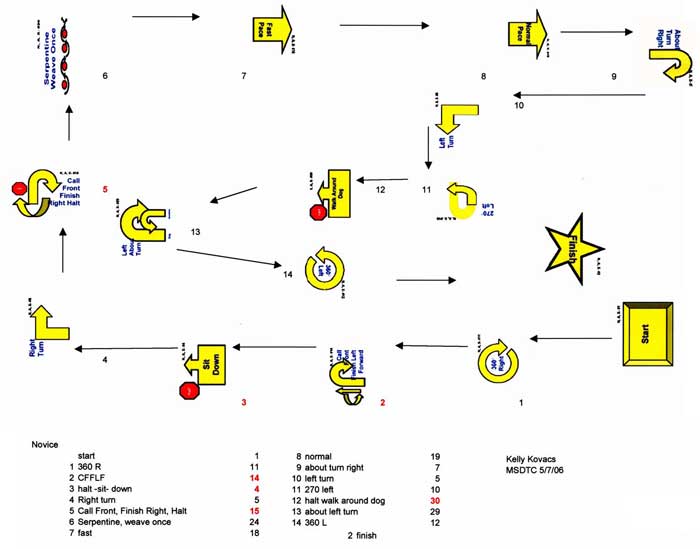
When I estimated there was about 10 minutes before I was expected on line, I went to go get Digital. He walked into the building eager and sure of himself. After all, this was his second day of Rally and he understood the game today. We warmed up by doing some heel work, sits and downs. He was rewarded with the treat du jour, which happened to be meatballs. I do this so that he knows what is at stake (steak?) if he performs well.
I put the meatballs in an empty chair when the dog before us was almost half way through the course. (You are not allowed to have food or toys when you perform.) We then waited behind the gate until the ring steward told us to go in.
When the steward told us to go in, I took a deep breath, told Digital it was time, and stepped up to the Start sign. With the Start sign on my right and Digital politely sitting at my left I waited for the judge to turn her attention to us. She does and asks if we are ready. I reply yes, she tells us to begin. Another deep breath, “Digs, heel” and I step off with my left foot. (My dogs have been trained that stepping off with my left foot, the foot closest to them, means “heel”. Stepping off with the right is accompanied with a “stay”.)
Our first station is a 360 right turn. I give Diggie an encouraging noise to let him know to pick up the pace as he has to cover more ground on a right turn and I pivot in place. “Not a problem, mom,” he seems to say. We go on to station 2, which is Call Front Finish Left Forward. Ah, we can do this, Digital has a lovely finish left, I just have to remember that since it doesn’t say to say “Halt” after the finish, I have step off before he sits. As I reach the sign, I take a step backwards and say “Digs, front.” Digital complies and sits directly in front of me close, but not touching my feet. “Digs, Finish,” I tell him as I gesture in a circular motion, palm down with my left hand. Digital complies and as soon as he is in heel position before he sits, I step off with my left foot.
Station 3 is HALT Sit Down. This is not difficult, but I have to remember not to move my feet once we stop. I plant my left foot and say “Digital, sit” as I bring my right foot even with the left. Digital sits promptly and I ask him to down, gesturing in a downward motion with my right hand, but careful not to move my feet. As soon as Digital is down I say “Digs heel” and step off with my left foot. And on to Right Turn. Again, since Digital will have to move a little faster than I am, I give him a little warning, make sure my left foot doesn’t get in his way and we do a smart right turn.
Station 5 is Call Front, Finish Right, Halt. So unlike station 2, I have to make sure he sits in heel position before I continue on. As I get up to the sign, I take a step or two backwards, say “Digs, Front” and bring both hands to my belly button. He sits nicely in front. “Digs, Around,” I tell him, gesturing with my right hand, palm down in a circular motion. He goes around me and sits in heel position. We step off to Station 6, which is Serpentine, weave once.
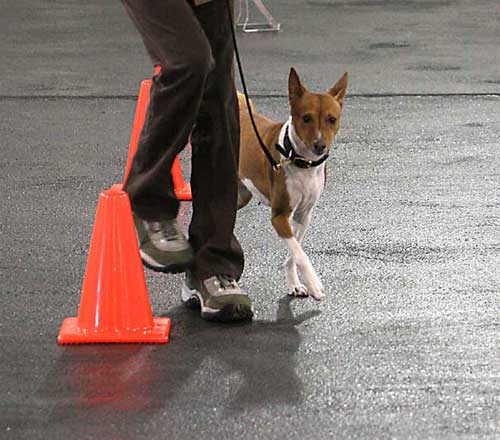 Photo of M, Mary Bloom, 1 Jan. 2005
Photo of M, Mary Bloom, 1 Jan. 2005
Weaving, not a problem for an agility dog. Digital thinks it is a little odd that I’m weaving with him, but he finds humans often do odd things. We enter with the first cone to our left shoulders, just like we do the poles in agility. In, out, in, out, around the last cone on to Fast Pace. I give Digital a little warning and we pick up the pace until we get to the sign that says Normal Pace. I pull my shoulders back a little and tell him “Easy”.
Station 9 is About Turn Right. Again I give him a little warning and do an about turn. This station is very close to the gates marking the ring and just on the other side there is a cluster of dogs waiting to go back into the ring next to ours. Digital is momentarily distracted and had I been more aware of my surroundings I would have given him a little more direction, but I was focused on the next station and I felt the leash go tight. Station 10 is Left Turn and as I was doing that I was wondering if I should have redone the about turn. The left turn isn’t really difficult; just let the dog know he needs to slow a tad to remain in heel position. And we’re on to a 270 left turn. I signal to Digital with my left hand to keep him in position and we quickly do the turn and move on to Halt walk around dog.
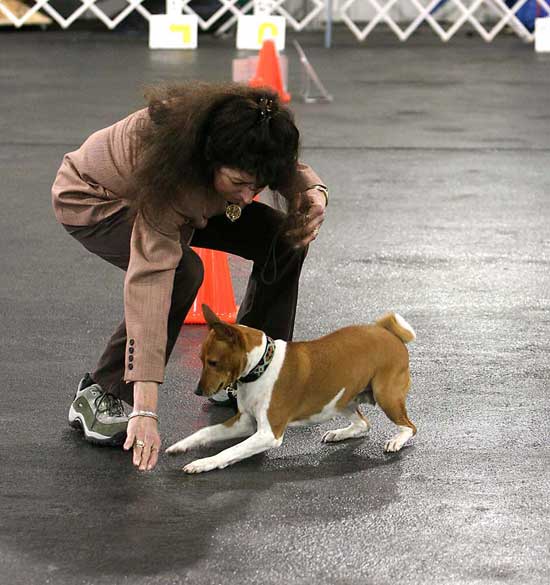 Photo of M, Mary Bloom, 1 Jan. 2005
Photo of M, Mary Bloom, 1 Jan. 2005
I ask him to sit as I’m stopping. As soon as his butt hits the ground, I tell him to stay, wave my right hand, palm open, in front of his nose and step off with my right foot. I walk around him, being careful not to tangle the leash and return to heel position and pause just a fraction of a second before saying “Digs, heel.”
Station 13 is About left turn where I do an about turn into my dog and he goes around me to his right. Sounds confusing, and believe me, my friend had to show it to me several times before it made sense. I quickly turn into Digital and say “Digs, around” gesturing with my right hand, palm down in a circular manner. Just like I do when he’s doing a finish right (see station 5). I move the leash around behind me as Digital is moving. He slips easily into heel position and we’re onto station 14. Here there is a 360 Left. I talk to him a little and gesture with my left hand (the hand closest to him) to encourage him to keep moving. And then, the finish. We continue our brisk pace, making sure not to increase speed (points off for that, as it can be interpreted as adding a station) and exit the ring. Digital did a fine job and he is amply rewarded with a handful of meatballs.
After all was said and done, that performance earned us a score of 99 (out of 100) with our second first place. The point off was when the leash went tight at station 9 and clearly that was my error for not being more aware of our environment.
Here are a few things I’ve learned about Rally:
-It’s fun. Really.
-Basenjis can do this. Novice is all on leash.
-Dog on left; sign on right (or in front if the sign is a direction change)
-You can do this even if you have problems with “right” and “left”. (This is a big problem of mine.) All the signs have arrows on them. Just follow the arrow.
-You can repeat a station if you feel the need. There is a 3 point penalty, but you can still qualify.
-If the leash goes a little tight, don’t repeat the station. The judges here aren’t nearly as strict as I imagined. You’ll probably only get dinged a point, maybe two.
-If the sign says Halt, do not move your feet once you’ve stopped.
-You can ask to see your score after you finish. This will give you feed back on what to work on.
-Enter weave cones with the left shoulder to the cone, just like in agility.
-Everyone is encouraging and they really do enjoy seeing a dog not from the herding group.
-Judges are really surprised when they look down at the scorecard and realize a basenji got first place.
-You always go home with the best dog.
![]()
![]()
![]()
Where to begin
by Nancy Banask
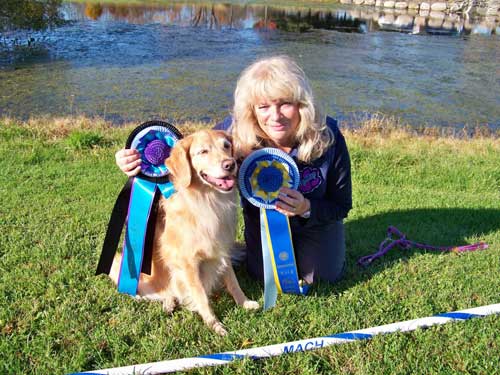
Nancy with OTCH MACH 3 Nikki ` photo by Di Henry
Attention is one of the first things I teach to a dog that I am planning to do rally and obedience with. I think it is very important to teach attention. How much fun would it be doing rally with a dog focused on something else? To begin I start with stationary attention. First I ask the dog to sit, then I bring a treat to his nose and then bring it to my face saying READY! When the dog looks at me I give him/her the treat. I repeat this several times with numerous treats. I like to use soft food that is very exciting to the dog. I practice this every day for 1 week or 2 and then I start to hold the dog's attention for a longer period of time. Once the dog understands to watch me until I give the release work I then will start moving attention. I add distractions and turns to start proofing the dog once he understands to watch me when I say ready. As I release and say OK I will reward the dog with the treat or jackpot.
In the Basic or Beginning obedience classes I start with teaching the dogs not to pull.
Week 1 - Walk on leash, sit - stay.
Week 2 - I teach change of pace (slow, normal, fast) and about turns and the come fore exercise (Call front), sit - stay and down- stay.
Week 3 - Come fore with sit in front, weave left and right - serpentine, circle right - 360, and circle left, sit and walk around dog.
Week 4 - Recall, One step, halt , 2 steps, halt, 3 steps, halt. Step Right while walking (moving sidestep), recall and stand - stay.
Week 5 - Figure 8, Right turn, Left turn, Recall with finish left or finish right, left about turn.
Week 6 - Practice and evaluation.
In the next level of obedience, Advanced, I continue to teach the doodling exercises with the addition of many more such as Spirals to the right or left, 270 turns right and left, left U turn, moving down, halt step to the right and halt, halt then fast forward from a sit. One of the most useful exercises in teaching the dog heel position is the Finding Heel exercise. The handler steps to the right, forward or backward and then asks the dog to heel. I also teach Pivot right and left, 90 and 180 pivots right and left and back-up while heeling. Run by and call over jumps are also used in the Advanced classes. Generally after completing the Basic obedience and the Advanced classes dog and handler are ready to compete in all the levels of Rally. I have always felt that all these exercises assist the dog in understanding of the basic obedience exercises.
Rally is fun for the dog and handler. It is a great way to introduce the dog to obedience competition. ![]()
![]()
![]()
![]()
Why did I want to try Rally?
by Natalie Culver
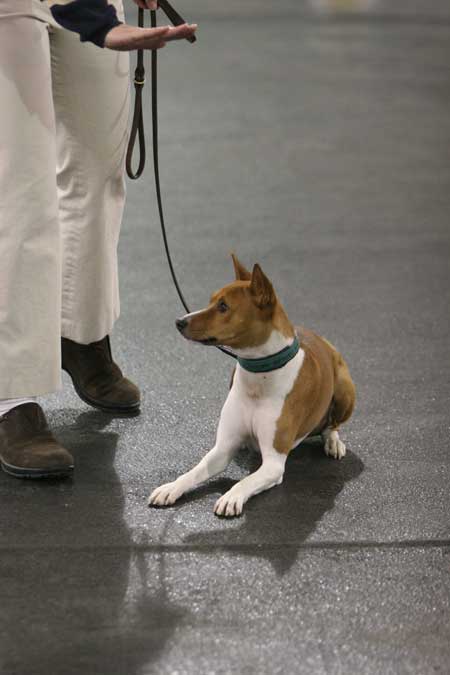 |
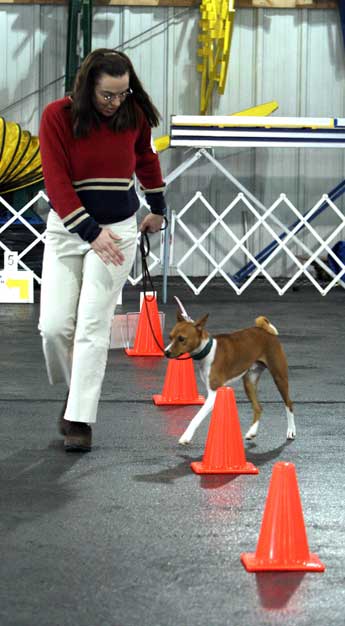 Kunjo & Natalie, photos by Mary Bloom, 2 Jan. 2005. Kunjo & Natalie, photos by Mary Bloom, 2 Jan. 2005. |
I first heard about rally obedience in the basenji breed article by Marcia Woodard in the November 2004 AKC Gazette. It was titled Basenjis and Rally Obedience: A Good Match. This caught my attention. See Marcia's new Rally article. Page 6.
I had been training agility with my 4 year old basenji, Kunjo, for over a year and we had just started competing. I have not ever trained for traditional obedience, frankly it seems not suited to Kunjo’s personality nor mine, but Woodard described this Rally Obedience as less formal, less rigid, and all around fun for the dogs. She wrote, “Rally Obedience, a new AKC event offered as a non-regular class effective January 1, 2005, is mentally stimulating, fast-paced, and rewards a variety of working styles - it suits basenjis.”
“It suits basenjis.” That says it all.
I had to learn more.
None of the local dog training facilities were offering rally classes, they said the interest was not there. This was the fall of 2004 and few people new about rally-O. They said I should check back later in 2005. The training places expected there would be interest in classes once it was an AKC titling class, but I was interested and there was going to be a rally trial on New Years weekend near me in Hamden, CT. I wanted to enter. I wanted to get in from the beginning, how much fun would to be at the very first two days of AKC rally trials! I decided I would have to train Kunjo on my own using books and internet resources.
I read the AKC Rally regulations. I joined and religiously read and learned from posts on a yahoo rally chat list. I printed the regulations and exercise sign instructions from the AKC web page; I read them, and re-read them, and highlighted the exercise instructions, and wrote in the margins. I taught some of the exercises to Kunjo, it came naturally to him, and he was having fun with it!
The Rally exercises were the perfect filler for the inevitable down time in our agility group classes. Kunjo could not stand this boring down time, waiting while all the other dogs took their turn on the equipment. I would only get one good training sequence out of him per class, and then he would get too bored and loose focus. He and I would get so frustrated in class as he got more and more bored waiting his turn.
Now we had something fun to do while we waited. We worked on the Rally-O exercises for the better part of each hour long agility class, waiting patiently now for our turn. Now Kunjo was doing more and more good agility training sequences in class, mixed in with all that rally. We also worked at home, just a few minutes each evening, but it was never boring because we had so many different exercises to learn. We didn’t have to repeat the same thing over and over. Kunjo and I both enjoyed our 5 or 10 minutes of rally training each evening in the basement for the rest of the 2004 winter.
This got us ready for the three rally trials I had entered on the first two days of January 2005. We were not perfect, but by the third trial I had overcome enough of my nervousness to keep Kunjo calm enough to qualify! It was Kunjo’s first qualifying ribbon in an AKC event, and mine too.
I agree with Marcia Woodard. Rally Obedience suits basenjis.
Page 7 < previous page > <next page>